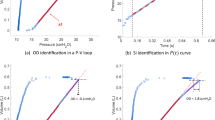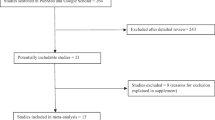Abstract
To determine the performance of bedside visual inspection of airway pressure-time (Paw–t) curve profiles (VI) for estimating stress index (SI) in patients with acute respiratory distress syndrome (ARDS). A prospective study in 30 subjects with ARDS receiving mechanical ventilation at two peak inspiratory flow (PIF) settings: 60 or 40 L/min. For each study session, two physicians inspected real-time Paw–t waveforms from mechanical ventilator’s monitoring screens at bedside for 30 s and interpreted which of the three patterns (tidal recruitment, noninjurious ventilation or tidal overdistension) the Paw–t curve profile was compatible with. Subsequently, the study was repeated again at the second PIF setting. SI was derived from a standardized dedicated software program and categorized into three groups: SI < 0.9, or tidal recruitment; SI = 0.9–1.05, or noninjurious ventilation; and SI > 1.05, or tidal overdistension. The lower PIF setting increased the sensitivity of VI to correctly estimate SI (75% vs. 50%; p = 0.005). At PIF 40 L/min, the likelihood ratio of a positive test was 3.6, 5.4 or 7 if the Paw–t curve profile was interpreted as noninjurious ventilation, tidal recruitment or tidal overdistension, respectively. The likelihood ratio of a negative test ranged from 0.55 for tidal recruitment to 0.32 and 0.19 for noninjurious ventilation and tidal overdistension, respectively. Experience in mechanical ventilation did not influence the accuracy. Bedside VI is moderately accurate for estimating SI and may be used to monitor injurious ventilation in patients with ARDS, in addition to plateau airway pressure.



Similar content being viewed by others
Abbreviations
- Pplat:
-
End-inspiratory plateau airway pressure
- SI:
-
Stress index
- Paw–t:
-
Airway pressure–time
- VI:
-
Visual inspection of airway pressure–time curve profiles
- PIF:
-
Peak inspiratory flow
- VT :
-
Tidal volume
- BF:
-
Baseline flow
- LF:
-
Lower flow
- LE:
-
Less experience
- ME:
-
More experience
- LR:
-
Likelihood ratio
- PLR:
-
Likelihood ratio of a positive test
- NLR:
-
Likelihood ratio of a negative test
References
Dreyfuss D, Saumon G. Ventilator-induced lung injury: lessons from experimental studies. Am J Respir Crit Care Med. 1998;157(1):294–323.
Slutsky A, Ranieri VM. Ventilator-induced lung injury. N Engl J Med. 2013;369(22):2126–36.
Curley GF, Laffey JG, Zhang H, Slutsky AS. Biotrauma and ventilator-induced lung injury: Clinical Implications. Chest. 2016;150(5):1109–17.
The Acute Respiratory Distress Syndrome Network. Ventilation with lower tidal volumes as compared with traditional tidal volumes for acute lung injury and the acute respiratory distress syndrome. N Engl J Med 2000;342:1301–18.
Kallet RH. The complexity of interpreting plateau pressure in ARDS. Respir Care. 2015;60(1):147–9.
Hager DN, Krishnan JA, Hayden DL, Brower RG; ARDS Clinical Trials Network. Tidal volume reduction in patients with acute lung injury when plateau pressures are not high. Am J Respir Crit Care Med. 2005;172(10):1241–5.
Terragni PP, Rosboch G, Tealdi A, Corno E, Menaldo E, Davini O, Gandini G, Herrmann P, Mascia L, Quintel M, Slutsky AS, Gattinoni L, Ranieri VM. Tidal hyperinflation during low tidal volume ventilation in acute respiratory distress syndrome. Am J Respir Crit Care Med. 2007;175:160–6.
Seeley E, McAuley DF, Eisner M, Miletin M, Matthay MA, Kallet RH. Respiratory system compliance and severity of hypoxemia as predictors of outcome in the acute respiratory distress syndrome. Thorax. 2008;63(11):994–8.
Seeley EJ, McAuley DF, Eisner M, Miletin M, Zhuo H, Matthay MA, Kallet RH. Decreased respiratory system compliance on day 6 of mechanical ventilation is a predictor of death in patients with established acute lung injury. Respir Res. 2011;12(1):52.
Chiumello D, Carlesso E, Cadringher P, Caironi P, Valenza F, Polli F, Tallarini F, Cozzi P, Cressoni M, Colombo A, Marini JJ, Gattinoni L. Lung stress and strain during mechanical ventilation for acute respiratory distress syndrome. Am J Respir Crit Care Med. 2008;178:346–55.
Grasso S, Terragni P, Mascia L, Fanelli V, Quintel M, Herrmann P, Hedenstierna G, Slutsky AS, Ranieri VM. Airway pressure-time curve profile (stress index) detects tidal recruitment/hyperinflation in experimental acute lung injury. Crit Care Med. 2004;32:1018–27.
Ranieri VM, Zhang H, Mascia L, Aubin M, Lin CY, Mullen JB, Grasso S, Binnie M, Volgyesi GA, Eng P. Slutsky AS. Pressure-time curve predicts minimally injurious ventilatory strategy in an isolated rat lung model. Anesthesiology. 2000;93:1320–8.
de Perrot M, Imai Y, Volgyesi GA, Waddell TK, Liu M, Mullen JB, McRae K, Zhang H, Slutsky AS, Ranieri VM, Keshavjee S. Effect of ventilator-induced lung injury on the development of reperfusion injury in a rat lung transplant model. J Thorac Cardiovasc Surg. 2002;124(6):1137–44.
Gama de Abreu M, Heintz M, Heller A, Szechenyi R, Albrecht DM, Koch T. One-lung ventilation with high tidal volumes and zero positive end-expiratory pressure is injurious in the isolated rabbit lung model. Anesth Analg. 2003;96:220–8.
Carvalho AR, Spieth PM, Pelosi P, Vidal Melo MF, Koch T, Jandre FC, Giannella-Neto A, de Abreu MG. Ability of dynamic airway pressure curve profile and elastance for positive end-expiratory pressure titration. Intensive Care Med. 2008;34:2291–9.
Ferrando C, Suárez-Sipmann F, Gutierrez A, Tusman G, Carbonell J, García M, Piqueras L, Compañ D, Flores S, Soro M, Llombart A, Belda FJ. Adjusting tidal volume to stress index in an open lung condition optimizes ventilation and prevents overdistension in an experimental model of lung injury and reduced chest wall compliance. Crit Care. 2015;19:9.
Grasso S, Stripoli T, De Michele M, Bruno F, Moschetta M, Angelelli G, Munno I, Ruggiero V, Anaclerio R, Cafarelli A, Driessen B. Fiore T. ARDSnet ventilatory protocol and alveolar hyperinflation: role of positive end-expiratory pressure. Am J Respir Crit Care Med. 2007;176:761–7.
Huang Y, Yang Y, Chen Q, Liu S, Liu L, Pan C, Yang C, Qiu H. Pulmonary acute respiratory distress syndrome: positive end-expiratory pressure titration needs stress index. J Surg Res. 2013;185:347–52.
Chiumello D, Cressoni M, Carlesso E, Caspani ML, Marino A, Gallazzi E, Caironi P, Lazzerini M, Moerer O, Quintel M, Gattinoni L. Bedside selection of positive end-expiratory pressure in mild, moderate, and severe acute respiratory distress syndrome. Crit Care Med. 2014;42:252–64.
Terragni PP, Filippini C, Slutsky AS, Birocco A, Tenaglia T, Grasso S, Stripoli T, Pasero D, Urbino R, Fanelli V, Faggiano C, Mascia L, Ranieri VM. Accuracy of plateau pressure and stress index to identify injurious ventilation in patients with acute respiratory distress syndrome. Anesthesiology. 2013;119:880–9.
Formenti P, Umbrello M, Graf J, Adams AB, Dries DJ, Marini JJ. Reliability of transpulmonary pressure-time curve profile to identify tidal recruitment/hyperinflation in experimental unilateral pleural effusion. J Clin Monit Comput. 2017;31(4):783–91.
Gattinoni L, Bombino M, Pelosi P, Lissoni A, Pesenti A, Fumagalli R, Tagliabue M. Lung structure and function in different stages of severe adult respiratory distress syndrome. JAMA. 1994;271(22):1772–9.
Bellani G, Laffey JG, Pham T, Fan E, Brochard L, Esteban A, Gattinoni L, van Haren F, Larsson A, McAuley DF, Ranieri M, Rubenfeld G, Thompson BT, Wrigge H, Slutsky AS, Pesenti A. LUNG SAFE Investigators; ESICM Trials Group. Epidemiology, patterns of care, and mortality for patients with acute respiratory distress syndrome in intensive care units in 50 countries. JAMA. 2016;315(8):788–800.
Schmidt GA. Counterpoint: should positive end-expiratory pressure in patients with ARDS be set based on oxygenation? No. Chest. 2012;141(6):1382–4.
Kallet RH. Should PEEP titration be based on chest mechanics in patients with ARDS? Respir Care. 2016;61(6):876–90.
ARDS Definition Task Force, Ranieri VM, Rubenfeld GD, Thompson BT, Ferguson ND, Caldwell E, Fan E, Camporota L, Slutsky AS. Acute respiratory distress syndrome: the Berlin definition. JAMA 2012;307:2526–33.
Jaeschke R, Guyatt G, Sackett DL. Users’ guides to the medical literature: III. How to use an article about a diagnostic test: what are the results and will they help me in caring for my patients? The Evidence-Based Medicine Working Group. JAMA. 1994;271:703–7.
Tobin MJ. Mechanical ventilation. N Engl J Med. 1994;330(15):1056–61.
Colombo D, Cammarota G, Alemani M, Carenzo L, Barra FL, Vaschetto R, Slutsky AS, Della Corte F, Navalesi P. Efficacy of ventilator waveforms observation in detecting patient-ventilator asynchrony. Crit Care Med. 2011;39(11):2452–7.
McGee S. Simplifying likelihood ratios. J Gen Intern Med. 2002;17(8):646–9.
Acknowledgements
The authors would like to express their appreciation to Khemajira Karaketklang for statistical assistance; and Sarun Kraivee for his technical assistance with ‘Datalogger’.
Funding
This research received no specific grants from any funding agency in the public, commercial, or non-profit sectors.
Author information
Authors and Affiliations
Contributions
PW is guarantor for the entire manuscript. PW contributed to the conception, hypothesis, outline, and design of the study; data acquisition; data analysis; drafting the manuscript; and substantial involvement in its revision prior to submission. NY contributed to the design of the study; data acquisition; drafting the manuscript; and substantial involvement in its revision prior to submission.
Corresponding author
Ethics declarations
Conflict of interest
The authors declare that they have no conflict of interest.
Ethical approval
All procedures performed in studies involving human participants were in accordance with the ethical standards of the institutional and/or national research committee and with the 1964 Helsinki declaration and its later amendments or comparable ethical standards.
Informed consent
Informed consent was obtained from all individual participants or the participants’next of kin.
Rights and permissions
About this article
Cite this article
Wongsurakiat, P., Yuangtrakul, N. Performance and applications of bedside visual inspection of airway pressure–time curve profiles for estimating stress index in patients with acute respiratory distress syndrome. J Clin Monit Comput 33, 281–290 (2019). https://doi.org/10.1007/s10877-018-0153-0
Received:
Accepted:
Published:
Issue Date:
DOI: https://doi.org/10.1007/s10877-018-0153-0




